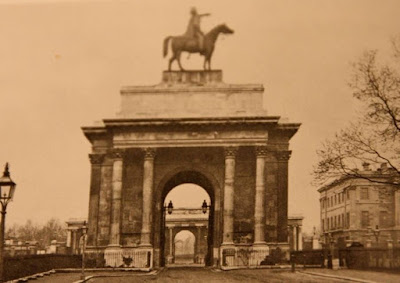Heading for the entrance
The remainder of the former menageries: sculptured lions
Our Guide, a Beef Eater aka Yeoman Warder
He explained to us the significance of the wonderful display of hand-made ceramic poppies. One was cast for each person killed from Great Britain and the Commonwealth, almost 800,000, to be placed around the Tower of London by the anniversary of the conclusion of World War I on November 18, 1818. It was, he pointed out to us in September 2014, one hundred years since the beginning of the Great War, or, as he slyly added, “For you Americans, 97 years!”
Each poppy is hand-made
The final spray of poppies, to be preserved,
by popular demand
For more information about the art installation Blood Swept Lands and Seas of Red,
click here.
Kristine and I soon abandoned the tour and struck out to find the Wellington Exhibition
as advertised on large posters around London. Example below.
As you can imagine we were eager to see this exhibition at the Tower.
We started out assured by a guard we would find it if we just kept going…
We didn’t even stop to see whose bed this was.
We squeezed through cramped corridors and around one narrow curving staircase after another. and often peeked through windows and arrow slits.
Farther and farther…
Ar least we got a good view of the nooks and crannies of the Tower ramparts
“On 15 June 1845, the Duke of Wellington, hero of the Battle of Waterloo and Constable of the Tower, laid the foundation stone of these barracks, named after his greatest victory. Built to house up to 1,000 soldiers, the barracks were designed by the Royal Engineers, The soldier outside is part of the garrison tradition, still active and guarding the Tower today.
Today, the Waterloo Barracks contain a smaller barracks, offices and the Jewel House. The building also overlooks the military Parade Ground. The ceremonial public duty of the soldiers stationed here is to guard the Crown Jewels and the Queen’s House on behalf of the monarch. They can come from any branch of the armed forces of Britain and the Commonwealth.”
The text panel above was repeated in ten additional languages
Hot on the Trail: we’re almost there.
\
Sucess. But this is all there was, a set of images including the equivalent of a power-point show. We found The Wellington Exhibition at the Tower completely underwhelming.
The White Tower
the line for the Crown Jewels
Tower Bridge
Where the poppies were just beginning to be placed
The White Tower
A distant view of the White Tower
The Traitor’s Gate
The wall along the Thames
The poppies from the west
Seeing the poppies was the highlight of the visit to the Tower. And we did negotiate the entire circumference of the place, up and down, in and out, ad nauseum, with a disappointing result. Actually, in retrospect it was pretty amusing to think of the long trek when we could have simply walked through the lawns and found the Wellington Barracks instead of going the long way around. And since Kristine is an expert on Wellington, and I am not so bad myself (says Victoria immodestly), what did we think we would learn? I guess we were hoping for a tidbit of new materials. To no avail!
On the plus side, we got some exercise, some good shots of the Tower, and a very memorable view of those incredible poppies.
Next, we re-crossed London to Horse Guards in Whitehall for the Afternoon Ceremonies.
Horse Guards
The Horse Guards building, which served as the British Army’s headquarters for many years, was designed by William Kent (1685-1748) and built by John Vardy between 1750 and 1753. It is a masterpiece of the Palladian style. The Duke of Wellington occupied offices here for a large part of his life.
Two mounted guards from the Household Cavalry are in place every day and a great attraction for the tourists along Whitehall. Each afternoon, the Daily Inspection takes place at 4 pm.
Following the Inspection, we toured the Household Cavalry Museum, which opens onto the Parade Ground behind the building. Their Website is here.
By this time, we were ready for a return to the hotel for a rest before our special dinner at The Grenadier, which we will describe next week.












